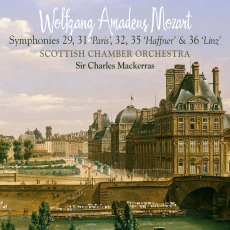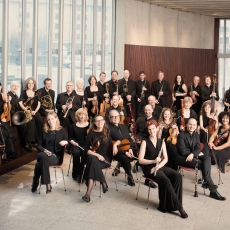Mozart Symphonies 2 - SCO & Sir Charles Mackerras - Audio Video Club of Atlanta
Sir Charles Mackerras' long-awaited Volume 2 of Mozart Symphonies sounds, to my ears, even better than the initial 2008 release of Symphonies 38-41. A major plus is that sir Charles has really focused here on the rhythmic flexibility and the relaxed freedom of the inner movements of the five symphonies heard here. The slow movements are the key. Mozart seldom marked a slow movement Adagio (although he does so in 36), preferring a quicker, more vital Andante with occasional side steps into a minor key for contrast, and he never wrote a Largo. His Minuets are likewise quick and invigorating, with subtle and delightfully contrasted trios.
In Symphony 29 in A, K201, the Minuet departs from the usual procedure in that the witty theme keeps recurring, each time punctuated by a fragment of a horn call before we get to the glowing trio in E-flat. Most performances of this work, witness to the 17-year-old composer's precocious maturity, stress the alertness of the outer movements, the Allegro moderato with its sensational crackling call to attention in the unison strings, and the rollicking Allegro finale. While Mackerras doesn't stint on the obvious fireworks, he does take the opening movement in moderate time as indicated, throwing the greater emphasis on the slow movement, an Andante so deliciously charming and varied we wish it would go on forever. Mackerras' relaxed treatment of this movement, in which every turn of the path seems to promise new riches, recalls similar procedures in Mozart's occasional music, his serenades and divertimenti.
No. 31 in D in three movements, K297 is known as the "Paris" Symphony after the place where it was premiered. The grandeur of this work, particularly noticeable in the beginning of the opening Allegro assai, is partly explained by the fact that Mozart had at his disposal somewhat larger forces that he was accustomed to enjoy, including pairs of flutes, oboes, clarinets, bassoons, horns, and trumpets, in addition to the tympani (which really sound great in this recording) and the usual strings. Then, as now, there was simply no accounting for Parisian taste; Mozart was obliged to substitute an alternative slow movement, a graceful, soothing Andante, in place of the original slow movement, a brisker Andantino that we are told, "failed to please." Symphony 32 in G, K318 is unusual in that it is in only two movements, a bravura Allegro spiritoso and a luxuriant Andante. As the opening movement ends suddenly without a coda, and since the two movements compliment each other perfectly, Mackerras takes No. 32 for what it is in fact, a lithesome concert overture.
For many listeners, No. 35 in D Major, K385, the "Haffner," is their favorite Mozart symphony. To judge from the present performance by Mackerras and the Scottish Chamber Orchestra, it's not hard to guess why. Sir Charles has clearly divined the secrets that make this scintillating work so successful: continual movement plus continuous surprises such as the way Mozart uses sharp dotted rhythms and an explosive forte from the whole orchestra in the opening movement to arrest the listener's attention and the way he employs silences followed by rapid dynamic shifts to keep us off balance in the brilliant Presto finale. Mozart expressly stated that the work was to be played "with fire," and Mackerras takes him at his word. The middle movements are no less effective: a warm, delicate, and gracious Andante, accented by chorale-like passages in the horns, and a bright Minuet that has a lot of fun with its forte and piano contrasts, and is in turn contrasted with a more flowing Trio section. Both these middle movements have a very relaxing effect on the listener.
Mackerras and the SCO score many of their best points in what was Mozart's most ambitious and mature symphony to date, No. 36 in C Major, the "Linz." If the Haffner Symphony is in many ways the symphonic counterpart of opera buffa (light opera), the Linz is opera seria, at least in the sad, slow Adagio introduction to the opening movement. The music becomes increasingly chromatic, and the mood of the introduction continues to be felt even after the brilliant and spacious Allegro spiritoso main section commences and holds the stage through to the end. The Adagio movement, a lilting Siciliano in a pastoral mood, takes a disquieting turn with the appearance of trumpets and drums, heralding the shift to a minor mode. The complexity of mood in this movement "recalls" (before the fact) arias of Mozart's conflicted heroines such as Susannah and Pamina. An ascending figure at the end pulls the movement back from the brink of curiously tragic implications. (Especially considering that the signature of the work as a whole, C Major, was considered the key of "sunlight and simple happiness" by 18th century theorists!) The Minuet, a model of economy and rhythmic ingenuity, is succeeded by a triumphant and contrapuntally muscular Presto for the final. Mackerras really lets ‘er rip here, bringing a symphony in which the course of happiness has not always run smoothly to a resounding and highly satisfactory conclusion.


